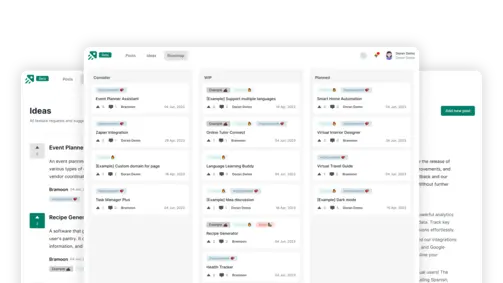SaaS Product Management Strategy
Create changelog and product roadmap for your product
Explore nowTable of contents 6 min
A strong SaaS product management strategy is crucial for success in today’s competitive market. This guide explores the key components and best practices of saas product management, providing insights and strategies to effectively develop, launch, and manage SaaS products that meet customer needs and drive business growth.
Components of a Successful SaaS Product Management Strategy
Effective product management is vital for the success of any SaaS business. A well-defined and executed SaaS product management strategy ensures that the right products are built, launched, and maintained to meet customer needs and drive business growth. Here are the key components of a successful SaaS product management strategy:
Market Research and Analysis
In-depth market research and analysis form the foundation of a successful SaaS product management strategy. This involves understanding the target market, identifying customer pain points, and analyzing market trends and competition. By gaining insights into customer needs and market dynamics, product managers can make informed decisions and shape their product strategy accordingly.

Product Definition and Roadmap
The product definition and roadmap are essential components of a SaaS product management strategy. This involves clearly defining the product vision, identifying the core features and functionalities, and prioritizing the roadmap based on customer needs and business goals. A well-defined product roadmap serves as a guide for the development team and ensures alignment with the overall product strategy.
Suggested Post: A Complete Guide to SaaS Pricing Strategy
Agile Product Development
Adopting an agile approach to product development is crucial for SaaS companies. Agile methodologies enable product managers to iterate quickly, gather feedback, and make necessary adjustments to meet evolving customer requirements. By following agile principles such as Scrum or Kanban, product teams can deliver incremental value, respond to market changes, and maintain a competitive advantage.
User Experience Design
User experience (UX) plays a critical role in the success of a SaaS product. A user-centric design approach focuses on creating intuitive and seamless experiences that delight customers. This involves conducting user research, designing intuitive interfaces, and continuously improving the UX through user feedback and usability testing. By prioritizing UX design, SaaS companies can enhance customer satisfaction, drive adoption, and reduce churn.
Data-Driven Decision Making
Data-driven decision making is a key component of an effective SaaS product management strategy. By leveraging data analytics and metrics, product managers can gain insights into user behavior, product usage, and performance. This data-driven approach allows for informed decision making, identification of improvement areas, and the ability to make data-backed decisions on product enhancements, pricing strategies, and feature prioritization.

Cross-Functional Collaboration
Successful SaaS product management relies on strong cross-functional collaboration. Product managers must work closely with engineering, design, marketing, and sales teams to ensure alignment and effective execution of the product strategy. Regular communication, collaboration, and a shared understanding of goals and priorities are essential for delivering a cohesive and successful SaaS product.
By incorporating these key components into their SaaS product management strategy, companies can create a solid foundation for product success. A comprehensive and well-executed strategy will help drive innovation, meet customer needs, and achieve long-term growth in the dynamic and competitive SaaS market.
Best Practices for SaaS Product Management
Successful SaaS product management requires a combination of strategic planning, customer-centricity, and effective execution. This article explores key best practices that can help product managers excel in their roles, deliver exceptional SaaS products, and drive business growth.
Building Customer-centric Products Through User Research and Validation:
To build successful SaaS products, product managers must deeply understand their target customers and their needs. Conducting user research, such as interviews, surveys, and usability testing, allows product managers to gather valuable insights that inform product decisions. By involving customers throughout the development process and validating ideas and features with them, product managers can ensure that the final product aligns with customer expectations and solves their pain points effectively.
Effective Product Documentation and Knowledge Sharing:
Clear and comprehensive product documentation is vital for successful SaaS product management. Documenting product requirements, specifications, and features ensures that the entire team has a shared understanding of the product vision and roadmap. Additionally, well-documented processes and guidelines enable smooth collaboration between cross-functional teams. Product managers should also encourage knowledge sharing within the organization, creating a repository of best practices, lessons learned, and product insights that can be accessed by team members to enhance their understanding and decision-making.

Balancing Technical Debt and Product Scalability:
In the fast-paced SaaS industry, product managers often face the challenge of balancing short-term feature development with long-term product scalability. It’s important to strike a balance between addressing customer needs and maintaining a scalable and maintainable product infrastructure. Proactively managing technical debt, prioritizing architectural improvements, and investing in scalable solutions help ensure that the product can accommodate future growth and evolving customer requirements. Regularly reassessing technical debt and making strategic decisions based on business priorities are key to managing the product’s long-term success.
Proactive Product Support and Customer Engagement:
Providing excellent customer support and engaging with customers proactively are critical components of successful SaaS product management. Product managers should establish effective channels for customer support and be responsive to customer inquiries, feedback, and feature requests. Actively engaging with customers through user communities, webinars, or user conferences helps build strong relationships, gain insights into customer needs, and identify opportunities for product improvements. By actively listening to customers and addressing their concerns, product managers can foster customer loyalty and drive product adoption.
Adhering to these best practices can greatly enhance the effectiveness of SaaS product management. By building customer-centric products through user research and validation, ensuring effective product documentation and knowledge sharing, balancing technical debt and product scalability, and providing proactive product support and customer engagement, product managers can deliver exceptional SaaS products that meet customer needs, drive business growth, and maintain a competitive edge in the dynamic SaaS industry. Embracing these best practices allows product managers to navigate the challenges of product management successfully and create value for both customers and the organization.
In conclusion, a well-executed SaaS product management strategy is essential for navigating the complexities of the SaaS industry and achieving sustainable growth. By implementing the right processes, tools, and methodologies, companies can effectively drive innovation, deliver value to customers, and maintain a competitive edge in the dynamic SaaS market.
What to not miss out on our blog
Gain insightful knowledge and invaluable experiences from dedicated experts.

CRM System Explained: Benefits, Types, and How It Works
Discover everything about CRM system. Learn the benefits and how a CRM system works to improve customer relationships and streamline business operations.

Are you ready? Start your free trial today.
Enhance communication, keep track of the progress, understand customers' insight and more by taking your first trial on Doran.
Sign up for free

